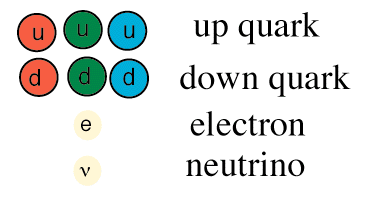
|Intro| - |Sizes| - |Tour| - |Help|
<Quarks> - [Nucleons] - [Nucleus] - [Atom] - [Cell] - [People]
All we know about the size of quarks is that they are too small for us to measure them using existing accelerator and experimental methods, so theorists treat them as if they were point particles.
.....

... some discussion of the quark model will go here ...
For additional information, I suggest following the first part of the Standard Model Path at the Contemporary Physics Education Project website, particularly the section around where they talk about nucleons and quarks.
When we also include electrons, neutrinos, and the electric and weak forces in our model, we can describe everything about matter from the nucleon to the nucleus to the atom, including chemistry and biology. This all-encompassing description of matter is called the standard model.

This picture shows the first generation part of the standard model. All of normal every-day matter is made up of these particles, where we add the electron and neutrino to the quarks. These particles interact by exchanging special particles called bosons, shown ...
There are two more generations, where the particles are grouped in t the same way and interact by exchanging the same set of bosons, with the only difference being that the particles are heavier. The properties of these other generations are studied in High Energy Physics. For additional information, visit The Particle Adventure website of the Contemporary Physics Education Project. You can also find more information about the standard model on the Fermilab (FNAL) server.